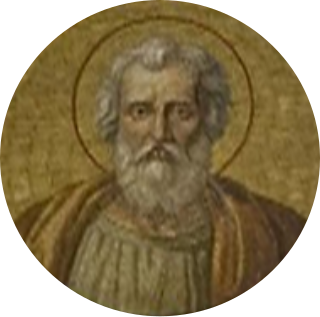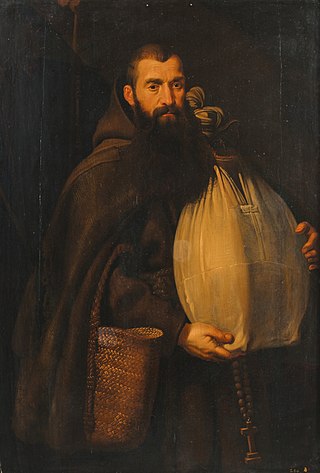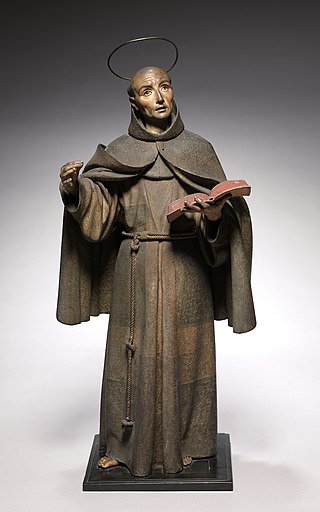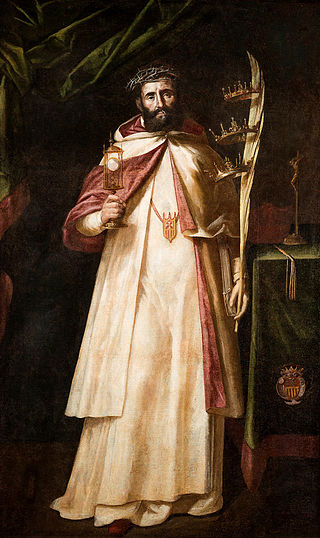
Antipope Felix II, an archdeacon of Rome, was installed as Pope in 355 AD after the Emperor Constantius II banished the reigning Pope, Liberius, for refusing to subscribe to a sentence of condemnation against Saint Athanasius.

Pope Innocent I was the bishop of Rome from 401 to his death on 12 March 417. From the beginning of his papacy, he was seen as the general arbitrator of ecclesiastical disputes in both the East and the West. He confirmed the prerogatives of the Archbishop of Thessalonica, and issued a decretal on disciplinary matters referred to him by the Bishop of Rouen. He defended the exiled John Chrysostom and consulted with the bishops of Africa concerning the Pelagian controversy, confirming the decisions of the African synods.

Pope Felix I was the bishop of Rome from 5 January 269 to his death on 30 December 274.

Pope Anacletus, also known as Cletus, was the bishop of Rome, following Peter and Linus. Anacletus served between c. AD 80 and his death, c. AD 92. Cletus was a Roman who, during his tenure as pope, ordained a number of priests and is traditionally credited with setting up about twenty-five parishes in Rome. Although the precise dates of his pontificate are uncertain, he "...died a martyr, perhaps about 91". Cletus is mentioned in the Roman Canon of the mass; his feast day is April 26.

Pope Zephyrinus was the bishop of Rome from 199 to his death on 20 December 217. He was born in Rome, and succeeded Victor I. Upon his death on 20 December 217, he was succeeded by his principal advisor, Callixtus I. He is known for combating heresies and defending the divinity of Christ.

Pope Marcellinus was the bishop of Rome from 30 June 296 to his death in 304. A historical accusation was levelled at him by some sources to the effect that he might have renounced Christianity during Emperor Diocletian's persecution of Christians before repenting afterwards, which would explain why he is omitted from lists of martyrs. The accusation is rejected, among others, by Augustine of Hippo. He is today venerated as a saint in the Catholic Church and in the Serbian Orthodox Church.

The Feast of Corpus Christi, also known as the Solemnity of the Most Holy Body and Blood of Christ, is a liturgical solemnity celebrating the real presence of Christ in the Eucharist; the feast is observed by the Latin Church, in addition to certain Western Orthodox, Lutheran, and Anglican churches. Two months earlier, the institution of the Eucharist at the Last Supper is observed on Maundy Thursday in a sombre atmosphere leading to Good Friday. The liturgy on that day also commemorates Christ's washing of the disciples' feet, the institution of the priesthood, and the agony in the Garden of Gethsemane.

The Servite Order, officially known as the Order of Servants of Mary, is one of the five original mendicant orders in the Roman Catholic Church. It includes several branches of friars, contemplative nuns, a congregation of religious sisters, and lay groups. The order's objectives are the sanctification of its members, the preaching of the Gospel, and the propagation of devotion to the Mother of God, with special reference to her sorrows. The Servites friars lead a community life in the tradition of the mendicant orders.

The Trinitarians, formally known as the Order of the Most Holy Trinity and of the Captives, is a mendicant order of the Catholic Church for men founded in Cerfroid, outside Paris, in the late 12th century. From the very outset, a special dedication to the mystery of the Holy Trinity has been a constitutive element of the order's life.

The Immaculate Heart of Mary is a Catholic devotion which refers to the view of the interior life of Mary, her joys and sorrows, her virtues and hidden perfections, and, above all, her virginal love for God the Father, her maternal love for her son Jesus Christ, and her motherly and compassionate love for all mankind. Traditionally, the Immaculate Heart is depicted pierced with seven swords or wounds, in homage to the seven dolors of Mary and roses, usually red or white, wrapped around the heart.

Felix of Cantalice, OFMCap was an Italian Capuchin friar of the 16th century. Canonized by Pope Clement XI in 1712, he was the first Capuchin friar to be named a saint. He worked as a shepherd and farmhand until he was twenty-eight. His task as a Capuchin was to beg alms for the friars. So successful was he that Brother Felix was able to extend his collections to assist the poor.

Peter of Alcántara, OFM was a Spanish Franciscan friar who was canonized in 1669.

The Solemnity of Mary, the Holy Mother of God is a feast day of the Blessed Virgin Mary under the aspect of her motherhood of Jesus Christ, whom she had circumcised on the eighth day after his birth according to Levitical Law. Christians see him as the Lord and Son of God.

The Dedication of the Basilica of St Mary Major is a feast day in the General Roman Calendar of the Catholic Church, optionally celebrated annually on 5 August with the rank of memorial.

Raymond Nonnatus, O. de M., is a saint from Catalonia in Spain. His nickname refers to his birth by Caesarean section, his mother having died while giving birth to him.

John of Matha, OSsT (1160–1213) was a French Catholic priest and cofounder of the Order of the Most Holy Trinity, initially dedicated to ransoming Christians who had been captured by marauders from North Africa.

Lawrence Justinian was a Venetian Catholic priest and bishop who became the first Patriarch of Venice. He is venerated as a saint by the Catholic Church.

The Feast of the Most Precious Blood of Our Lord Jesus Christ was in the General Roman Calendar from 1849 to 1969. It was focused on the Blood of Christ and its salvific nature.

The Feast of the Most Holy Name of the Blessed Virgin Mary is an optional memorial celebrated in the liturgical calendar of the Catholic Church on 12 September. It has been a universal Roman Rite feast since 1684, when Pope Innocent XI included it in the General Roman Calendar to commemorate the victory at the Battle of Vienna in 1683. It was removed from the Church calendar in the liturgical reform following Vatican II but restored by Pope John Paul II in 2002, along with the Feast of the Holy Name of Jesus.
The Blessed Arthur O'Neilly was born in Ireland in the 13th century. He was ordained a priest in the Trinitarian Order and assigned to care for and try to free Christians who were imprisoned, enslaved and held for ransom by Muslim slave traders around the Mediterranean Sea. The Trinitarian Order was oriented towards this goal, and there are several other members of the order who experienced trial in this line of work, e.g. Saint John of Matha, Saint Felix of Valois, and Saint Raymond Nonnatus.




















